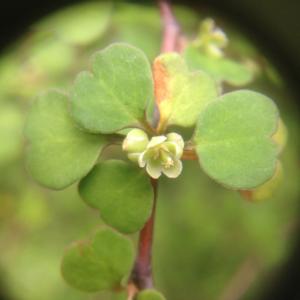Muehlenbeckia astonii
(Muehlenbeckia astonii)

Description
Muehlenbeckia astonii or shrubby tororaro is an endemic New Zealand shrub in the family Polygonaceae. It has distinctive small heart-shaped deciduous leaves amidst a tangle of wiry interlocking branches. Although common in cultivation around the world, it is extremely rare and threatened in the wild. Muehlenbeckia astonii was described by Donald Petrie in 1911, and named Muehlenbecki Astoni after Bernard Aston, who collected the specimens in Palliser Bay at the mouth of the Wainuiomata River in 1908. The type specimen is in Museum of New Zealand Te Papa Tongarewa, Wellington. The name "shrubby tororaro"distinguishes it from the similar species tororaro (Muehlenbeckia complexa), a scrambling plant with no trunk. It sometimes goes by the names wiggy-wig bush,[note 1] zig zag plant,wirebrush shrubby pōhuehue, or mingimingi (a generic term for many small-leaved shrubs) This species was probably once widely distributed in the drier lowland and coastal parts of eastern New Zealand, especially on terraced riverbeds, possibly as far south as the Waitaki Valley, South Canterbury. Its former range is hard to determine, as the species was only recognised by botanists decades after most of New Zealand's dry scrublands had been cleared for agriculture. Its deep root system helps it survive in dry conditions, and can grow on open rocky hillsides and stony ground, up to 300 metres (980 ft) altitude. It prefers free-draining, warm, sunny slopes, on moderately- to highly-fertile soil. Today M. astonii is only found in four areas
Taxonomic tree:







